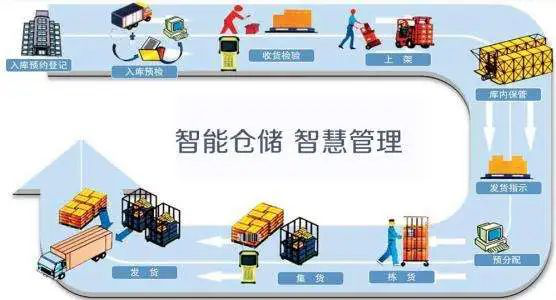RFID makes warehousing and logistics management easier
As production demands diversify and increase, warehousing and logistics efficiency has become an important management and control link. RFID realizes the automation, informatization, and intelligence needs of enterprise logistics operations. It can grasp the inventory status of warehouses in real time and accurately, and provides a scientific basis for various management departments to optimize inventory and production and operation decisions. RFID makes warehousing and logistics management easier. .
First, RFID tags are attached to each cargo to bind data information. RFID readers are installed in each area of the channel warehouse to determine the process of goods entry, exit, allocation, warehouse shifting, inventory counting, etc., through RFID reading and writing Automated data collection is carried out to ensure the speed and accuracy of data input in all aspects of warehouse management, ensuring that enterprises can grasp the real inventory data in a timely and accurate manner, achieving efficient cargo search and real-time inventory counting, which is conducive to improving the efficiency of warehouse management. Work efficiency, get rid of the time-consuming and laborious traditional warehouse management, reasonably maintain and control the company’s inventory, and enable the company to operate efficiently.
As RFID technology gradually matures, its applications are becoming more and more widespread. RFID front-end equipment (tags, card readers) combined with enterprise core systems can be widely used in the fields of supply chain and warehousing logistics management, effectively solving the input/output of various business operation data, business process control and control in the supply chain. tracking, and reducing error rates.
Retail link
RFID can improve retailers’ inventory management, enable timely replenishment, effectively track transportation and inventory, improve efficiency, and reduce errors. At the same time, smart labels can monitor the expiration date of certain time-sensitive products; stores can also use RFID systems to implement automatic scanning and billing at the checkout counter, thus replacing manual payment collection. RFID tags have great appeal in the sales process at the end of the supply chain, especially in supermarkets, because they eliminate manual intervention in the tracking process and can generate 100% accurate business data.
Storage link
In warehouses, the most widespread use of radio frequency technology is for accessing goods and inventory counting. It can be used to automate inventory and pickup operations. In the entire warehouse management, the receipt plan, pickup plan, shipping plan, etc. formulated by the supply chain planning system are combined with radio frequency identification technology to efficiently complete various business operations, such as designated stacking areas, shelf pickup, and Replenishment etc. In this way, the accuracy and speed of operations are enhanced, service quality is improved, costs are reduced, labor and inventory space are saved, and at the same time, the entire logistics process is reduced due to product misplacement, wrong delivery, theft, damage, inventory, and shipments. Losses caused by errors, etc. Another benefit of RFID technology is the reduction of manpower during inventory counting. The design of RFID is to automate the registration of goods. There is no need for manual inspection or barcode scanning during inventory, which is faster and more accurate and reduces losses. RFID solutions provide accurate information about inventory status, allowing managers to quickly identify and correct operational inefficiencies, enabling rapid delivery and minimizing storage costs.
Transportation link
In transportation management, RFID tags are attached to goods and vehicles transported in transit, and RFID receiving and forwarding devices are installed at some checkpoints along the transportation line. After the receiving device receives the RFID tag information, it is uploaded to the communication satellite together with the location information of the receiving place, and then the satellite transmits it to the transportation dispatch center and enters it into the database.
Delivery/distribution link
In the distribution process, the use of radio frequency identification technology can greatly speed up the speed of distribution and improve the efficiency and accuracy of the picking and distribution process. It can also reduce labor and distribution costs. If all goods arriving at the central distribution center are RFID tagged, when entering the central distribution center, the pallet passes through a reader and reads the tag content on all the boxes on the pallet. The system checks this information against shipping records to detect possible errors and then updates the RFID tag with the latest location and status of the item. This ensures precise inventory control and even knows exactly how many boxes are currently in transit, the origin and destination of the transfer, and expected arrival time.
Production processes
The application of RFID technology in the manufacturing process can complete the operation of automated production lines, realize the identification and tracking of raw materials, parts, semi-finished products and finished products throughout the production line, reduce manual identification costs and error rates, and improve efficiency and benefits. After adopting RFID technology, it is possible to quickly and accurately find the raw materials and parts required for the workstation from a wide range of inventory by identifying electronic tags. RFID technology can also help managers send out replenishment information in a timely manner according to production progress, achieve balanced and stable production on the assembly line, and also strengthen quality control and tracking.
RFID technology interconnects data between the entire warehouse management and radio frequency identification technology to quickly and efficiently complete various business operations, improve warehouse management, and enhance efficiency and value. The application of RFID in warehousing and logistics management can shorten the warehouse inventory cycle, improve the real-time nature of data, dynamically grasp the inventory situation in real time, and achieve visual management of inventory items.
Post time: Dec-04-2023


